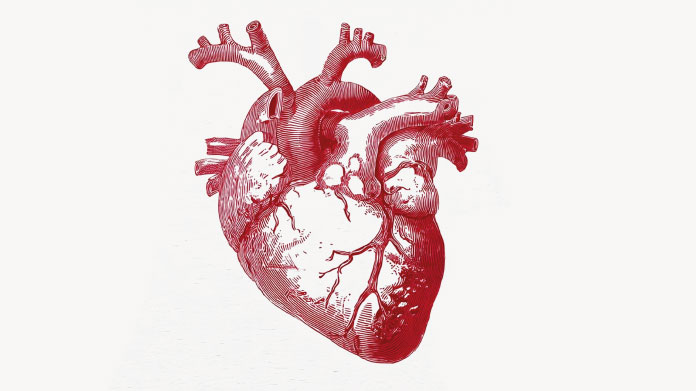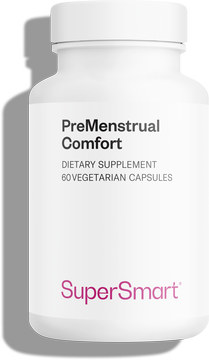Is it better to take pure omega-3, or omega-3 enriched with omega-6?
Is it better for your health to take a supplement containing just omega-3 or one that combines omega-3 and omega-6?

Omega-3 and omega-6: essential fatty acids!
To maintain certain structural functions, our bodies need two types of polyunsaturated fatty acid (1):
- omega-3s (or n-3 PUFAs), the essential precursor of which is alpha-linolenic acid (ALA) from which eicosapentaenoic acid (EPA) and docosahexaenoic acid (DHA) can be synthesised;
- and omega-6s (or n-6 PUFAs), the precursor and major example of which is linoleic acid (LA).
Contrary to popular belief,omega-6 fatty acids are indeed essential to health. In particular, they act as precursors for the synthesis of prostaglandins (lipid mediators which primarily act on platelets, the endothelium, the uterus and mastocytes) and leukotrienes (which act on inflammation and bronchoconstriction).
A diet too high in omega-6?
However, since the 1950s, livestock (primarily cattle, pigs and chickens) have, to a very large extent, been fed with corn sileage or soybean meal. And unsurprisingly, this omega-6-heavy diet produces meat that’s also higher in omega-6.
What’s more, mass-produced cakes and pastries are made using omega-6-rich oils, for the simple reason that they’re less expensive (peanut, soya, sunflower, rapeseed) and thus provide the manufacturer with optimal returns.
Modern industrialised food therefore ends up producing a significant imbalance in our intake of omega-3 and omega-6.
The importance of omega-3:omega-6 balance
These two groups of fatty acids are actually metabolised in the body by the same enzymes, which leads to competition. If the diet is too high in certain fatty acids, the body is unable to metabolise the other type, hence the importance of achieving a satisfactory omega-3:omega-6 balance (2).
The World Health Organization recommends a ratio of 5-10 omega-6 (preferably 5 rather than 10) for 1 omega-3, (3). For an adult male consuming 2200 kcal a day, this equates to around 2g of omega-3 a day and 10g of omega-6, and for an adult female consuming 1800 kcal, 1.6g and 8g respectively.
However, the intakes actually required remain the subject of scientific debate as the ideal ‘protective’ ratio has not been definitively established by clinical studies.
As mentioned, current intakes of omega-6 in Europe are well above these figures: on average, 10-20 times more omega-6 is consumed than omega-3, a ratio which rises to 40 or even 50 to 1 in North America.
So rather than monitoring your omega-6 intake, it’s important to ensure a good balance of fatty acids by consuming foods high in omega-3 or by taking supplements targeted at taking care of this aspect of your health (4).
Omega-3-rich foods
ALA (precursor of omega-3 fatty acids) helps to maintain normal cholesterol levels (5) while EPA and DHA (omega-3 derivatives) support normal cardiac function (6), blood pressure (7) and blood triglycerides (8).
- ALA is found in land-sourced foods;
- EPA and DHA are primarily found in marine-source foods.
To re-balance your omega-3 and omega-6 intake, it’s thus important to start by avoiding processed foods especially cakes and pastries, reduce your consumption of meat and cheese and try to eat the following foods regularly (at least once or twice a week) (9):
- walnut oil;
- rapeseed oil;
- walnuts;
- flax seeds (ground or soaked to make them easier to digest) ;
- watercress, cabbage, spinach;
- salmon;
- tuna;
- mackerel, sardines, herrings, anchovies;
In addition, natural supplements offer an easy way of increasing your omega-3 intake.
Fish oils, a major source of EPA and DHA
Obtained by the pressing of oily fish tissues (herrings, sardines, anchovies, mackerel, salmon or cod, depending on whether the oil is produced from wild or farmed fish), fish oils are extremely rich in EPA and DHA (10).
For achieving an adequate omega-3 intake without harming the environment, you can opt for fish oils obtained from fisheries certified as sustainable, which protect the seabed and preserve fish stocks (such as Super Omega 3, also the purest fish oil on the market).
Depending on their particular focus (in particular, cardiovascular or brain health), some people opt for fish oil supplements with a higher content of EPA (such as Super EPA) or DHA (such as Super DHA). Either way, these specific oils provide all the benefits of omega-3.
Omega-3 from krill oil
Obtained from shrimp-like crustaceans, particularly Euphasia Superba, or Antarctic krill, krill oil provides the same benefits as fish oils because of its high content of EPA and DHA, the famous omega-3 fatty acids.
What’s more, krill oil is also rich in phospholipids, which promote the uptake and effects of DHA and EPA, as well as containing another powerful compound: astaxanthin (11) (try, for example, the supplement Krill Oil).
The unique composition of calanus oil
Obtained from another type of zooplankton (Calanus finmarchicus), found in the clean waters of the Nordic seas, calanus oil has a high content of wax esters, which are absorbed more easily by the body.
And calanus oil is rich not only in EPA and DHA like fish oil and krill oil, and in astaxanthin like krill oil, but also in stearidonic acid (SDA), another type of omega-3 fatty acid found primarily in hemp oil or spirulina (12).
Last but not least, the production of calanus oil helps to preserve fish stocks and maintain ecosystems, as calanus reserves in northern seas are thought to number more than 300 million tons of which only 0.1% is fished.
For all these reasons, many people choose to obtain omega-3’s health benefits by taking a calanus oil supplement (such as Arctic Plankton Oil).
References
- https://www.anses.fr/fr/content/les-lipides
- CANDELA, C. Gómez, LÓPEZ, LMa Bermejo, et KOHEN, V. Loria. Importance of a balanced omega 6/omega 3 ratio for the maintenance of health. Nutritional recommendations. Nutricion hospitalaria, 2011, vol. 26, no 2, p. 323-329.
- https://www.who.int/fr/news-room/fact-sheets/detail/healthy-diet
- https://www.efsa.europa.eu/fr/press/news/120727
- CHAN, Joanna K., BRUCE, Vivian M., et MCDONALD, Bruce E. Dietary α-linolenic acid is as effective as oleic acid and linoleic acid in lowering blood cholesterol in normolipidemic men. The American journal of clinical nutrition, 1991, vol. 53, no 5, p. 1230-1234.
- KRIS-ETHERTON, Penny M., HARRIS, William S., et APPEL, Lawrence J. Omega-3 fatty acids and cardiovascular disease: new recommendations from the American Heart Association. Arteriosclerosis, thrombosis, and vascular biology, 2003, vol. 23, no 2, p. 151-152.
- GUO, Xiao-fei, LI, Ke-lei, LI, Jiao-mei, et al.Effects of EPA and DHA on blood pressure and inflammatory factors: a meta-analysis of randomized controlled trials. Critical reviews in food science and nutrition, 2019, vol. 59, no 20, p. 3380-3393.
- VON SCHACKY, Clemens. A review of omega-3 ethyl esters for cardiovascular prevention and treatment of increased blood triglyceride levels. Vascular health and risk management, 2006, vol. 2, no 3, p. 251.
- MEYER, Barbara J., MANN, Neil J., LEWIS, Janine L., et al.Dietary intakes and food sources of omega‐6 and omega‐3 polyunsaturated fatty acids. Lipids, 2003, vol. 38, no 4, p. 391-398.
- KRIS-ETHERTON, Penny M., HARRIS, William S., et APPEL, Lawrence J. Fish consumption, fish oil, omega-3 fatty acids, and cardiovascular disease. circulation, 2002, vol. 106, no 21, p. 2747-2757.
- XIE, Dan, GONG, Mengyue, WEI, Wei, et al.Antarctic krill (Euphausia superba) oil: A comprehensive review of chemical composition, extraction technologies, health benefits, and current applications. Comprehensive Reviews in food science and food safety, 2019, vol. 18, no 2, p. 514-534.
Keywords
4 Days
Great customer service - responsive …
I ordered from them and my item was unavailable for sometime. I was super happy when they reactivated my order and shipped my item which arrived very quickly. Great customer service.
Ruth Rueter
5 Days
Super fast shipping
Super fast shipping
Donald Borling
8 Days
Reputable companysearch and the number of…
The research and the number of selection of products.
NAKHJAVAN Shervin
21 Days
The Anti Aromatase is a great product
The Anti Aromatase is a great product. You just need to have constant inventory. Recently this product has been out of stock.
GEORGE Verne
22 Days
Great help on chat
Great help on chat. Knowledgeable and friendly.
Jason Argos
26 Days
Customer service was fast and friendly.
Customer service helped to stop the transaction process of the subscription. I appreciated that.
Greenie
26 Days
I order here due to the high quality of…
I order here due to the high quality of the products and the quick delivery of items - thank you
Barbara J
27 Days
SuperSmart's Eye Pressure supplements: highly recommended!
I purchase SuperSmart's Eye Pressure supplements regularly for over 5 years, and gotta say they are truly a wonderful product for my Glaucoma. Highly recommended if you have eye pain from your Glaucoma.
D. Martinez
32 Days
Quick service
Quick service
MONELL
33 Days
Speedy service.
Speedy service.
ROSENTHAL Marvin
36 Days
Clear website- Efficient
Clear website. Excellent search engine and fast delivery!
Mohamad Hussein
39 Days
They have great products.
They have great products.
Vickie
39 Days
Great Shipping Time!
You Have A Great Shipping Time! Praise The Lord!
DMHoge
41 Days
Doctor Recommended!
Good pricing, very good availability, doctor recommended (couldn't find what I needed anywhere else), and it took only a week to arrive (which I can't complain about).
Al
42 Days
Great product and fast shipping
Great product and fast shipping
Marie


.jpg)


